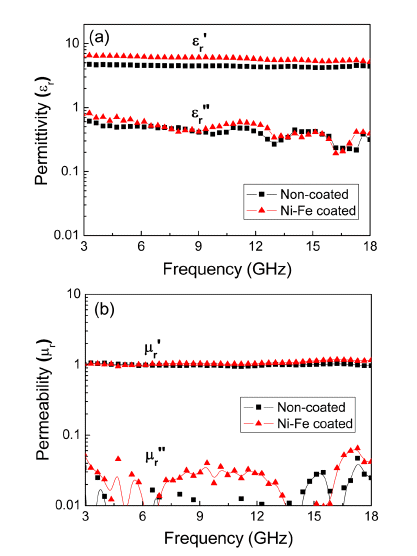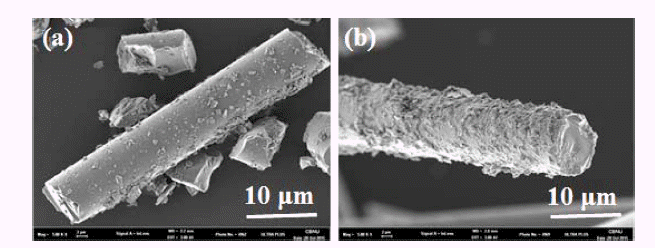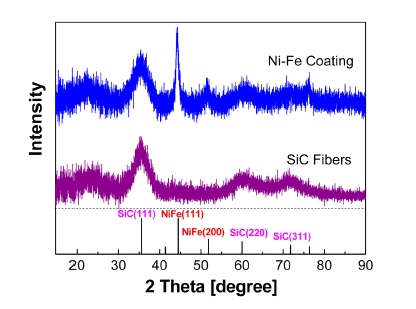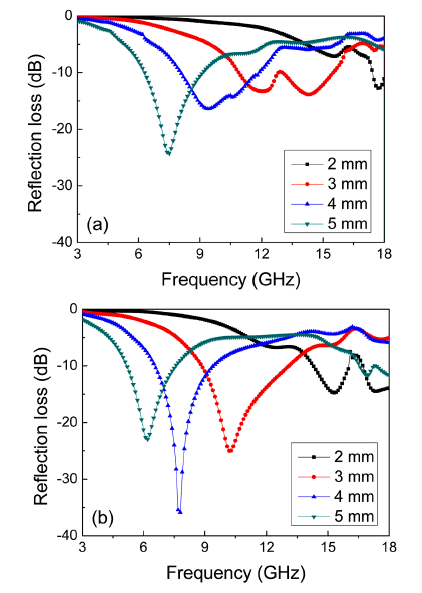Articles
- Page Path
- HOME > J Korean Powder Metall Inst > Volume 25(5); 2018 > Article
-
ARTICLE
- Microwave Absorbance of Polymer Composites Containing SiC Fibers Coated with Ni-Fe Thin Films
- Tian Liua, Sung-Soo Kima,*, Woo-cheal Choib, Byungil Yoonb
-
Journal of Korean Powder Metallurgy Institute 2018;25(5):375-378.
DOI: https://doi.org/10.4150/KPMI.2018.25.5.375
Published online: September 30, 2018
a Department of Advanced Materials Engineering, Chungbuk National University, Cheongju 361-763, Republic of Korea
b DACC Carbon Co. Ltd., Unam-ro 30, Deokjin-gu, Jeonju 561-202, Republic of Korea
- *Corresponding Author: Sung-Soo Kim, TEL: +82-43-261-2418, FAX: +82-43-271-3222, E-mail: sskim@chungbuk.ac.kr
• Received: September 7, 2018 • Revised: September 18, 2018 • Accepted: October 11, 2018
© The Korean Powder Metallurgy Institute. All rights reserved.
- 857 Views
- 5 Download
- 1 Crossref
Abstract
- Conductive and dielectric SiC are fabricated using electroless plating of Ni–Fe films on SiC chopped fibers to obtain lightweight and high-strength microwave absorbers. The electroless plating of Ni–Fe films is achieved using a two-step process of surface sensitizing and metal plating. The complex permeability and permittivity are measured for the composite specimens with the metalized SiC chopped fibers dispersed in a silicone rubber matrix. The original noncoated SiC fibers exhibit considerable dielectric losses. The complex permeability spectrum does not change significantly with the Ni–Fe coating. Moreover, dielectric constant is sensitively increased with Ni–Fe coating, owing to the increase of the space charge polarization. The improvements in absorption capability (lower reflection loss and small matching thickness) are evident with Ni–Fe coating on SiC fibers. For the composite SiC fibers coated with Ni–Fe thin films, a -35 dB reflection loss is predicted at 7.6 GHz with a matching thickness of 4 mm.
- Silicon carbide (SiC) is a dielectric structural ceramic material having high strength and hardness, low density, good resistance to oxidation, high thermal stability and high thermal conductivity at elevated temperatures [1-3]. Additionally, SiC is a good potential microwave absorbing materials due to its high dielectric loss in microwave radiation [4-6]. Compared to glass fibers, polymerderived SiC fibers have higher modulus and wide range of electrical resistivity by tailoring the compositions or surface characteristics, which can develop their microwave absorbing applications [7-11]. It was reported that the ion jump and dipole relaxation through the reorientation of lattice defect pairs is the dominant factor for the high dielectric loss [6]. However, the absorption capability of SiC is not satisfactory as a single absorber, due to the difficulty in precise control of its dielectric property leading to impedance matching. It is generally utilized as an auxiliary absorbent in other materials or after surface treatments to enhance the absorption capability [12-14].
- In resonant absorbers of quarter wavelength, zeroreflection can be obtained by access to wave impedance mating at the surface of the absorbing layer, which requires a proper combination of magnetic permeability and dielectric permittivity at a given thickness and frequency. Those material parameters in high frequencies can be controlled by use of magnetic metals (permittivity control by electrical property and permeability control by magnetic property) in a single-layered microwave absorber [15]. In this study, Ni-Fe films are coated on SiC chopped fibers through electroless plating for the control of high-frequency electromagnetic properties and its effect on microwave absorbance is investigated.
Introduction
- Commercially available SiC fibers (DACC Carbon Co. Ltd., Korea) were used as absorbent filler materials. The SiC fibers with a diameter of 5 μm have a low density of 3.2 g/cc. The fibers were chopped into about 0.5 mm length. Ni-Fe (10 mol%) films were coated on the fibers in a two-step operation: surface sensitiZing and metal plating. The surface sensitization was conducted in a catalyst solution of PdCl2, SnCl2·2H2O, and HCl. The surface- sensitized microspheres were placed in plating solution and the mixture was tumbled at 70-80°C for 1 h. Table 1 shows the chemical agents (metal salts, reducing agent, complexing agent, and pH modifier) used in electroless plating of Ni-Fe films. The microspheres were gravity filtered, washed with distilled water and air dried at 60°C. The batch was repeated two times for the complete coating of the metal film.
- The coating morphology Ni-Fe film and its crystal structure were verified using a scanning electron microscope (SEM: Carl Zeis/LEO-1530) and X-ray diffraction (XRD: PANAnalytical/X’Pert PRO MRD). The complex permeability and permittivity was measured in the composite specimens with the metalized SiC chopped fibers dispersed in a silicone rubber matrix. Composite specimens were prepared using RTV (room temperature vulcanization) silicone rubber as a matrix material. The mixing ratio of SiC fibers to rubber was 1 by weight. The mixture was molded into a coaxial die with a 3-mm inner diameter, 7-mm outer diameter, and approximately 2-mm thickness for microwave measurement. Curing at room temperature for about 10 h under a pressure of 0.1 ton/cm2 produced the flexible and dense composite specimens.
- Toroid samples were inserted in a standard coaxial sample holder, and the reflection coefficient (S11 parameter) and transmission coefficient (S21 parameter) were measured using a network analyzer (HP 8722D). The complex permittivity and permeability was calculated from the S11 and S21 parameters. The reflection loss was determined through measuring the S11 parameter after the rear face of the sample was terminated by metal.
Experimental Procedure
- Fig. 1 shows the SEM observation of the non-coated and Ni-Fe coated SiC chopped fibers. Cylindrical SiC particles with an average diameter of about 5 μm and length of 0.5 mm were observed (Fig. 1(a)). Fig. 1(b) shows the microstructure of the SiC fibers coated with Ni-Fe films. Non-uniform but nearly complete coating of Ni-Fe film is observed. The XRD patterns of Ni-Fe coated SiC fibers further confirmed the incorporation of Ni-Fe grains, as depicted in Fig. 2. A broad peak at 2θ = 35°, which corresponds to Bragg's diffraction from SiC (111) plane, reveals the amorphous nature of SiC fibers. Another sharp diffraction peak at 2θ = 44° corresponds to the reflections from the (111) planes of Ni-Fe alloy.
- Fig. 3 shows the complex permeability (μr = μr′ - jμr") and complex permittivity (εr = εr′ - jεr") determined in the composite specimen containing Ni-Fe coated SiC chopped fibers. The amount of SiC fibers in rubber matrix (defined by F/R ratio in weight) was 1. For the composite of non-coated SiC fibers, dielectric constant is εr′ = 4.5 and a considerable value of dielectric loss (εr″ ≅ 0.5) were estimated (Fig. 3(a)), which are almost constant (not dispersive) with frequency. It was reported that the ion jump and dipole relaxation through the reorientation of lattice defect pairs is the major factor for the high dielectric loss [6]. Because of non-magnetic property of the constituent materials, the constant values of complex permeability were determined to be μr′ ≅ 1.0 and μr″ ≅ 0.05 (Fig. 3(b)).
- With coating of Ni-Fe films, the dielectric constant increases gradually from εr′ = 4.5 (non-coated SiC) to εr′ = 6.0 (at 10 GHz), as depicted in Fig. 3(a). Higher value of dielectric constant with Ni-Fe coating is attributed to the electrically conductive nature of films. The space charge polarization between adjacent conductive particles (separated by insulating rubber matrix) gives rise to a higher value of dielectric constant. However, the dielectric loss is not greatly increased with Ni-Fe coating. It is believed that the main source of dielectric loss is the SiC fibers having a loss mechanism of dipole relaxation or dipole reorientation [6]. The increase in magnetic permeability and magnetic loss is not so great (Fig. 3(b)), which is due to small thickness of Ni-Fe film to respond to external magnetic field.
- For the composite layer terminated by metal, the input impedance at the layer surface (Zin) is given by the following equation:
- where Zo is the wave impedance of free space (= 377 Ω), λ is the wavelength in free space, and d is the layer thickness. Since the reflection coefficient Γ is proportional to the difference between Zin and Zo as expressed in Eq. (2), the reflection loss (RL) can be calculated from the measured material parameters (μr and εr) as a function of frequency and thickness.
- Fig. 4 presents the improvement of microwave absorbance by coating the SiC chopped fibers with Ni-Fe films. For the composite of non-coated SiC fibers, -25 dB reflection loss (99.6% power absorption) is predicted at 7.5 GHz with a layer thickness of 5 mm, as presented in Fig. 4(a). For the composite of SiC fibers plated with Ni- Fe film, a smaller matching thickness is predicted. At the thickness of 4 mm, -35 dB reflection loss (99.99% power absorption) is determined at 7.6 GHz, as depicted in Fig. 4(b). The improvement in absorption capability (lower reflection loss and small matching thickness) is evident with Ni-Fe coating on SiC fibers, which is mainly due to the increase in the dielectric constant of the composite samples.
Results and Discussion
Fig. 3

Material parameters measured from the composites of SiC chopped fibers (non-coated and plated with Ni-Fe films): (a) complex permittivity and (b) complex permeability.

- The most significant result of this study is that the lightweight and thin microwave absorbers with high absorption capability can be designed by using the SiC chopped fibers coated with Ni-Fe thin films. The original non-coated SiC fibers exhibited a considerable value of dielectric loss. The complex permeability spectrum is not greatly changed with Ni-Fe coating. On the while, dielectric constant is sensitively increased with Ni-Fe coating, due to the enhancement of space charge polarization. For the composite of SiC fibers coated with Ni- Fe thin film, the improvement in absorption capability (lower reflection loss and small matching thickness) is evident with Ni-Fe coating on SiC fibers. Reflection loss less than -30 dB was predicted at 7.6 GHz with a matching thickness of 4 mm.
Conclusions
-
Acknowledgements
- This research was supported by DACC Carbon Co. Ltd. funded by Jeonju Defense Venture Center of Defense Agency for Technology and Quality, and by Basic Science Research Program through the National Research Foundation of Korea (NRF) funded by the Ministry of Science, ICT & Future Planning (grant number: 2016R1A2B4007970). This work was conducted during the research year of Chungbuk National University in 2018.
Acknowledgments
- 1. H. Jin , M. Cao, W. Zhou and S. Agathopoulos: Mater. Res. Bull.., 45 (2010) 2470025-5408.Article
- 2. A. Fissel , B. Schroter and W. Richter: Appl. Phys. Lett.., 66 (1995) 31820003-6951.Article
- 3. V. Krstic : J. Amer. Ceram. Soc.., 75 (1992) 1700002-7820.Article
- 4. J. D. Santos , D. Garcia and J. Eiras: Mater. Res.., 6 (2002) 971516-1439.Article
- 5. H. Jin , D. Li, M. Cao, Y. Dou, T. Chen, B. Wen and A. Simeon: Chin. Phys. Lett.., 28 (2011) 0377010256-307X.Article
- 6. B. Zhang , J. Li, J. Sun, S. Zhang, H. Zhai and Z. Du: J. Euro. Ceram. Soc.., 22 (2002) 930955-2219.Article
- 7. F. Ye , L.T. Zhang, X.W. Yin, Y.S. Liu and L.F. Cheng: Appl. Surf. Sci.., 270 (2013) 6110169-4332.Article
- 8. D.Y. Wang , X.H. Mao, Y.C. Song and Y.D. Wang: China Technol. Sci.., 53 (2010) 1038.Article
- 9. T.J. Hu , X.D. Li, G.Y. Li, T.H. Li and H. Wang: J. Am. Ceram. Soc.., 94 (2011) 28080002-7820.Article
- 10. D.Y. Wang , Y.C. Song and Y.Q. Li: Trans. Nonferrous Met. Soc. China., 22 (2012) 11331003-6326.Article
- 11. T.J. Hu , X.D. Li, T.H. Li, H. Wang and J. Wang: Mater. Lett.., 65 (2011) 25620167-577X.Article
- 12. X. Liu , Z. Zhang and Y. Wu: Composites Part B., 42 (2011) 3261359-8368.Article
- 13. Y. Li and R. Wang: F. Qi and C. Wang: Appl. Surf. Sci.., 254 (2008) 4708.
- 14. C. Liang , C. Liu, H. Wang, L. Wu, Z. Jiang, Y. Xu, B. Shen and Z. Wang: J. Mater. Chem. A., 2 (2014) 163972050-7488.Article
- 15. S.-S. Kim , S.-T. Kim, J. -M Ahn and K. -H. Kim: J. Magn. Magn. Mater.., 271 (2004) 390304-8853.Article
Figure & Data
References
Citations
Citations to this article as recorded by 

- Magnetic sputtering of FeNi/C bilayer film on SiC fibers for effective microwave absorption in the low-frequency region
Tong Guo, Ben Huang, Changgeng Li, Yumin Lou, Xiu-Zhi Tang, Xiaozhong Huang, Jianling Yue
Ceramics International.2021; 47(4): 5221. CrossRef
Microwave Absorbance of Polymer Composites Containing SiC Fibers Coated with Ni-Fe Thin Films




Fig. 1
SEM morphology of (a) non-coated SiC chopped fiber, (b) Ni-Fe coated SiC fiber.
Fig. 2
XRD patterns determined from the original and Ni- Fe coated SiC fibers.
Fig. 3
Material parameters measured from the composites of SiC chopped fibers (non-coated and plated with Ni-Fe films): (a) complex permittivity and (b) complex permeability.
Fig. 4
Reflection loss determined in the composites of SiC chopped fibers: (a) non-coated and (b) plated with Ni-Fe films.
Fig. 1
Fig. 2
Fig. 3
Fig. 4
Microwave Absorbance of Polymer Composites Containing SiC Fibers Coated with Ni-Fe Thin Films
Table 1
Chemical agents used in the electroless plating of Ni-Fe on SiC chopped fibers.
Table 1
TOP
 KPMI
KPMI





 Cite this Article
Cite this Article




